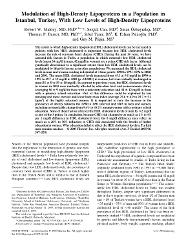| dc.contributor.author | Mahley, Robert W. | |
| dc.contributor.author | Can, Selçuk | |
| dc.contributor.author | Özbayrakçı, Sinan | |
| dc.contributor.author | Bersot, Thomas P. | |
| dc.contributor.author | Tanir, Sibel | |
| dc.contributor.author | Palaoğlu, K. Erhan | |
| dc.contributor.author | Pepin, Guy M. | |
| dc.date.accessioned | 2019-06-27T08:00:51Z | |
| dc.date.available | 2019-06-27T08:00:51Z | |
| dc.date.issued | 2005 | |
| dc.identifier.issn | 0002-9149 | en_US |
| dc.identifier.uri | https://hdl.handle.net/20.500.12469/123 | |
| dc.identifier.uri | https://doi.org/10.1016/j.amjcard.2005.04.018 | |
| dc.description.abstract | The extent to which high-density lipoprotein (HDL) cholesterol levels can be increased in patients with low HDL cholesterol is important because low HDL cholesterol levels increase the risk of coronary heart disease (CHD). During the past 14 years we have assessed risk factors in Turks a population in which extremely low HDL cholesterol levels (mean 36 mg/dl in men 42 mg/dl in women) are a prime CHD risk factor. Although genetically determined to a significant extent these low HDL cholesterol levels can be modulated by lifestyle factors as in other populations.'We measured the HDL cholesterol levels in men and women residing in Istanbul at 3 time points: 1990 to 1993 1996 to 2000 and 2003. The mean HDL cholesterol levels increased from 45.3 +/- 9.5 mg/dl in 1990 to 1993 to 49.7 +/- 12 mg/dl in 2003 (p < 0.0001) in women but were virtually unchanged in men (38 +/- 8 vs 39 +/- 10 mg/dl). In contrast to previous years the HDL cholesterol levels in women in 2003 were markedly affected by education level and socioeconomic status averaging 56 +/- 9 mg/dl in those with a university education and 48 +/- 12 mg/dl in those with a primary school education. Part of this difference could be explained by less smoking and more exercise and lower body mass index (average 25.6 +/- 4.9 vs 29.7 +/- 5.1 kg/m(2)) of the highly educated women. It is important to note the increase in the prevalence of obesity between the 1990 to 1993 interval and 2003 in men and womenincluding a remarkable change from 9.4% to 45.2% among women with a primary school education. None of these factors affected the HDL cholesterol levels of men by > 2 mg/dl at any of the 3 points. In conclusion because CRD risk changes by as much as 2% to 4% per 1 mg/dl difference in HDL cholesterol level the 8 mg/dl difference may reflect as much as a 20% to 30% reduction in CHD risk associated with the benefit of higher education in women. Why education failed to affect the HDL cholesterol levels in Turkish men remains unclear. (c) 2005 Elsevier Inc. All rights reserved. | en_US] |
| dc.language.iso | eng | en_US |
| dc.publisher | EXCERPTA MEDICA INC | en_US |
| dc.rights | info:eu-repo/semantics/openAccess | en_US |
| dc.subject | N/A | en_US |
| dc.title | Modulation of high-density lipoproteins in a population in Istanbul Turkey with low levels of high-density lipoproteins | en_US |
| dc.type | article | en_US |
| dc.identifier.startpage | 547 | en_US |
| dc.identifier.endpage | 555 | |
| dc.relation.journal | American Journal of Cardiology | en_US |
| dc.identifier.issue | 4 | |
| dc.identifier.volume | 96 | en_US |
| dc.identifier.wos | WOS:000231255100016 | en_US |
| dc.identifier.doi | 10.1016/j.amjcard.2005.04.018 | en_US |
| dc.identifier.scopus | 2-s2.0-23644432806 | en_US |
| dc.relation.publicationcategory | Makale - Uluslararası Hakemli Dergi - Kurum Öğretim Elemanı | en_US |
| dc.identifier.pmid | 16098310 | en_US |
















